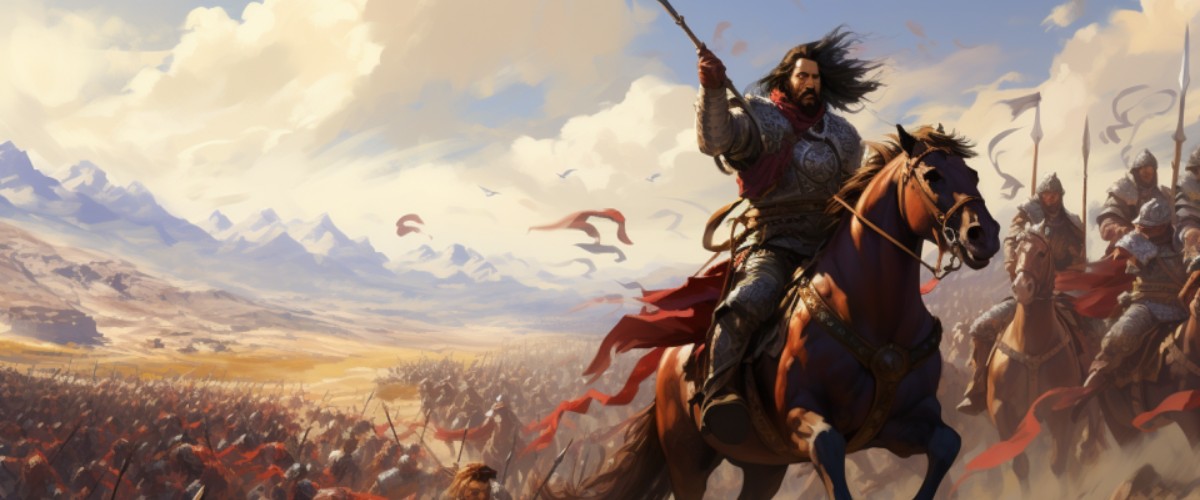The 13th-century Mongol Invasions, spearheaded by Genghis Khan and his successors, shaped the socio-political and cultural landscapes across Eurasia, setting a stage where nations either succumbed to the marauding forces or strategically navigated through the tempest of warfare and diplomacy.
Background
The Rise of Genghis Khan
- Temüjin’s Early Life: Born with the name Temüjin, Genghis Khan rose from humble beginnings amidst the harsh steppes of Mongolia.
- Unified Mongolia: He successfully united the scattered Mongol tribes under a single banner in the early 13th century.
- Expansionist Vision: Driven by a thirst for power, resources, and arguably, a strategic vision for his people, he embarked on an unprecedented spree of conquests.
Key Entities and Personalities
- Genghis Khan: The catalyst and epicentre of the invasions.
- Subsequent Leaders: His successors, notably his sons and grandsons like Kublai Khan, carried forward his militaristic legacy.
- The Mongol Army: Not just warriors, but also adept strategists, engineers, and spymasters, facilitating the conquest of vastly varied territories.
Major Happenings
- Invasion of the Khwarezmian Empire: A savage campaign as a response to the murder of Mongol envoys.
- Assault on Europe: Mongol forces reached as far as Hungary and Poland, instilling terror in the European kingdoms.
- Conquest of China: The Mongols dismantled the Jin and later the Song Dynasty, establishing Yuan Dynasty.
- Expedition to Japan: Though ultimately unsuccessful due to the “Divine Wind” (kamikaze), it demonstrated Mongol audacity in their conquest attempts.
Immediate Outcomes
Societal and Political Upheaval
- New Ruling Dynasties: The establishment of the Mongol-led Yuan Dynasty in China and the Ilkhanate in Persia.
- Pax Mongolica: The relative peace and stability across the vast Mongol Empire, facilitating trade and cultural exchanges.
- Massive Death Toll: Civilian populations were often massacred, leading to socio-economic destabilisation in the conquered regions.
Cultural and Economic Implications
- Silk Road: The security enabled by the Mongol dominance revitalised the ancient trade routes, fostering economic and cultural exchanges.
- Transmission of Knowledge: Science, technology, and various cultural practices were disseminated across the Eurasian continent.
Long-term Impact
Shaping Civilisations and Borders
- Yuan Dynasty: Markedly influenced Chinese administration and culture.
- The Fragmentation: After the demise of the unified Mongol Empire, various states formed, shaping future geopolitical landscapes.
- Moscow’s Rise: The decline of the Mongol-led Golden Horde facilitated Moscow’s emergence as a power centre in Russia.
Legacy of Interaction and Conflict
- East Meets West: The forced interaction between the Eastern and Western worlds seeded a complex tapestry of intercultural engagements.
- Disease Spread: The bubonic plague (Black Death) was inadvertently transmitted along the trade routes, wreaking havoc in Europe.
Conclusion
The Mongol Invasions were not merely a period of bloodshed and subjugation but also a catalyst that stirred the cauldron of global interchange, sowing seeds for future nation-states, and sparking unforeseen socio-cultural syntheses. Today, we find the echoes of the Mongol legacy in modern political boundaries, cultural exchanges, and the historical narratives of nations swept by the tide of the Mongol horde, serving as a reminder of the potent blend of brutality and ingenuity in shaping human civilisations.








